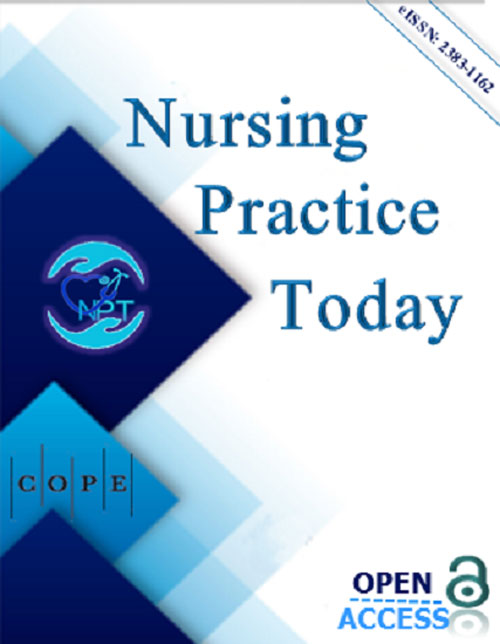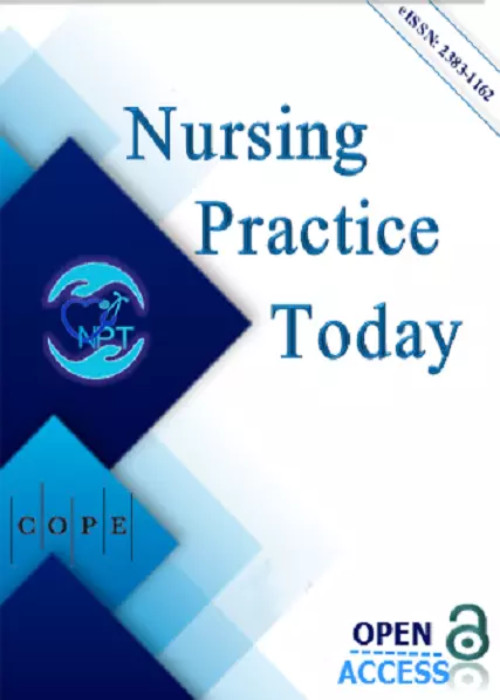فهرست مطالب

Nursing Practice Today
Volume:6 Issue: 4, Autumn 2019
- تاریخ انتشار: 1398/07/09
- تعداد عناوین: 8
-
-
Pages 167-175Background & Aim
Diabetes is one of the most common chronic metabolic disorders, and one of the essential health-related challenges in today’s world. In addition to different kind of disabilities, diabetes complications can severely impact the quality of life of patients. The present systematic review and meta-analysis are aimed at examining the quality of life of Iranian patients who have type 2 diabetes based on the World Health Organization Quality of Life-BREF.
Methods & MaterialsA total of 16 articles published in Persian and English were reviewed without any time limitation. The search was conducted in Iranian databases, including Scientific Information Database, Magiran, and IranMedex; and international databases, including Google Scholar, Web of Science, Pub Med, and Scopus. The data was examined using the meta-analysis method and the random-effects model. Heterogeneity was assessed using the I2 statistic. The analyses were conducted in Stata, version 11.
ResultsThe mean quality of life score for patients with type 2 diabetes was 61.90 (95% confidence interval: 54.40-69.40). The highest and lowest quality of life scores were for social support (49.19) and mental health (42.96) dimensions, respectively. No significant association was found between the mean quality of life score and year of publication, methodological quality, and mean age of participants (P>0.05).
ConclusionGiven that patients with type 2 diabetes have a lower quality of life, especially in terms of mental health, it seems necessary to better understand psychological problems common in this group of patients and design strategies to overcome them.
Keywords: diabetes mellitus, type 2, quality of life -
Pages 176-189Background & Aim
It is necessary to have a valid, reliable, and socio-cultural appropriate questionnaire for evaluation of women's sexual self-efficacy. Therefore, the objective of the study was the development and psychometric evaluation of the context-based questionnaire for women's sexual self-efficacy.
Methods & MaterialsThe study was conducted during two phases on clients visiting the healthcare centers of Tehran University of medical sciences in 2018. In the first phase, Iranian women' sexual self-efficacy, and its dimensions were explored through thematic analysis, and it was compiled in 24 items by the deductive-inductive method. In the second phase, the psychometric properties of the questionnaire were tested using face, content, construct, and criterion validity and reliability of the questionnaire was assessed by the intraclass correlation coefficient.
ResultsIranian women's sexual self-efficacy was defined as "women' ability to make sexual relationship which leads to mutual orgasm or sexual satisfaction." Sexual relationship, the proper level of sexual self-expression, women's ability in the management of her and husband's sexual response cycle and having the necessary skills to make a delightful sexual relationship were explored as the dimensions of definition of women’s sexual self-efficacy. Questionnaires were prepared with 24 items. The content validity index and content validity ratio (CVI and CVR) were found as 0.92 and 0.84, respectively. The results of qualitative and quantitative face validity and criterion validity were acceptable. Construct validity through exploratory factor analysis led to identifying four factors explained 66.68% of the variance. The items of the questionnaire were reduced from 24 to 21 after construct validity. The results of Cronbach’s alpha coefficient (0.94) and ICC (0.50) supported the acceptable stability of the questionnaire.
ConclusionThe psychometric properties of developed sexual self-efficacy questionnairewomen (SSEQ-W) has good validity and reliability. Therefore, it can be used as a useful tool in future studies.
Keywords: sexual self-efficacy, women, questionnaire, validity, reliability -
Pages 190-201Background & Aim
The caregivers of hemodialysis patients experience a heavy caregiving burden. More caregiving pressure and burden have been reported of the women than men insofar as they are encountered with more physical and psychological problems. This paper explores the challenges faced by women living with husband on hemodialysis.
Methods & MaterialsThe study followed a conventional content analysis method. The participants were selected through a purposive sampling method in hospitals of Shahid Beheshti University of Medical Sciences, Tehran, Iran, in 2017-2018. The first author performed semi-structured, individualized interviews with 14 participants.
ResultsBy analyzing the data, the main category "Immersing in problems" was extracted with two following categories: 1- Inadequate support network (subcategories: inadequate informational support, inadequate instrumental support, inadequate emotional support) and 2- Difficult coexistence with problems (subcategories: role overload, worry and anxiety, fear and hope for the future, suffering of frequent dialyses).
ConclusionThe findings of the study showed that women living with the husband on hemodialysis have been encountered with challenges and numerous stressing factors in the course of caregiving. Given the challenges experienced by participants, telenursing, and community health nurses can play an essential role in eliminating the many problems of hemodialysis patients and their caregivers.
Keywords: hemodialysis, caregiving, women, challenge -
Pages 202-211Background & Aim
Desirable bishop score is necessary for having a successful delivery. Prostaglandins are effective on cervical ripening, and primrose contains precursors of these materials. Therefore, the present study was conducted to evaluate the effect of vaginal Evening primrose on the bishop score among term nulliparous women.
Methods & MaterialsThe present double-blind, randomized clinical trial was conducted on 86 nulliparous women who referred to the comprehensive health service centers of Rafsanjan from November 2017 to May 2018. The samples were selected through convenient sampling method and allocated into two intervention and placebo groups with simple random assignment. The intervention group used a daily dose of 1000 mg vaginal capsules of Evening primrose from the 38th week of pregnancy until delivery, and the placebo group received a similar placebo with a similar administration method. The Information about the women’s bishop score was gathered from the participants’ medical files in the hospital and then was analyzed using SPSS software version 16 and Kolmogorov-Smirnov test, Chi-square test, and independent t-test.
ResultsThe total mean and standard deviation of the bishop score in the intervention and placebo groups were respectively 7.83 ± 2.09 and 4.46 ± 2.39, and the simplified bishop score in the intervention and the control groups was respectively 5.93 ± 2.42 and 2.81 ± 2.02. The difference between the two groups considering both of the bishop scores was statistically significant (p = 0.001).
ConclusionVaginal Evening primrose is useful to ripen the cervix of term nulliparous women, and so, it could be administered for this purpose.
Keywords: evening primrose, vaginal, cervical ripening, bishop score, nulliparous -
Pages 212-222Background & Aim
One of the main concerns in patients with myocardial infarction is that there is no return to sexual activities. Sexual counseling is an interaction between patient and nurse that requires appropriate performance, responsibility, and confidence. The present study aimed to determine nurses' performance, responsibility, and confidence in sexual counseling of myocardial infarction patients.
Methods & MaterialsThis descriptive/analytical cross-sectional study was carried out on 180 nurses from the cardiac care unit (CCU) at the hospitals located in southeastern Iran in 2018. Sampling was performed with the census method; and the data collection tool was a demographic information form and questionnaire, involving nurses' performance, responsibility, and confidence in sexual counseling of cardiac patients. Information was analyzed using SPSS software (ver.18) through descriptive and inferential statistics, including t-test, ANOVA, and Pearson correlation coefficient. The significance level was considered as 0.05.
ResultsThe mean of total performance scores in the nurses was 14.54 ± 4.4, indicating the average performance of nurses in the sexual counseling of myocardial infarction patients. The total mean score of responsibility was 14.32±2.7, indicating their average responsibility in sexual consultation. The total mean score of confidence was 12.86±2.35, indicating their average confidence in the sexual counseling of cardiac patients.
ConclusionThe present research showed that nurses’ performance and confidence were not high or acceptable in the sexual counseling of patients with a myocardial infarction, which can lead to some dangerous events such as recurrent myocardial infarction or sudden death. Thus, holding some workshops or training related to the sexual counseling of the patients can assist nurses to be better in this case.
Keywords: nurses, responsibility, confidence, myocardial infarction, sexual counseling -
Pages 223-228Background & Aim
Nurses often work in problematic work environments, characterized by various difficulties and stress-factors that can undermine nurses’ full capacity to provide excellent care. Also, the nurse practice environment can have an impact on the quality of work-life, nurse recruitment and retention, and quality patient outcomes. Thus, the study assessed the relationship between practice environment and work-related quality of life as perceived by nurses in a selected hospital in Zamboanga City, Philippines.
Methods & MaterialsA descriptive correlational design was used in the study, and the total population of nurses was recruited as participants. The Practice Environment Scale of the Nursing Work Index and Work-Related Quality of Life Scale were used to gather the needed data. Data were analyzed using mean, standard deviation, and Spearman rank-order correlation.
ResultsA total of 103 nurses were surveyed in the study. In the perceived practice environment scale, it was revealed that the nursing foundation for quality of care was the highest (M=3.01, SD=0.20) and staffing and resource adequacy was the lowest (M=2.56, SD=0.45). On the other hand, job career satisfaction was the highest (M=3.64, SD=0.57) and stress at work was the lowest (M=2.55, SD=0.22) in the perceived work-related quality of life scale. The study showed a significant relationship between the perceived practice environment and perceived work-related quality of life (rho=0.287, p=0.003).
ConclusionThe study revealed that nurses have a favorable work-related quality of life and practice environment. However, formulating and enhancing programs for nurses such as incentive and professional development should be done as this can help foster and sustain a positive practice environment and job satisfaction.
Keywords: health facility environment, nurses, quality of life -
Pages 229-238Background & Aim
Since women experience numerous physical and psychological changes after childbirth, the postnatal period is a sensitive stage for mothers, and they should have access to essential information to cope with these changes. This study aims to determine the predicting factors of the postnatal information needs of Afghan immigrant women living in Iran.
Methods & MaterialsThe present research is a cross-sectional study performed on 280 Afghan pregnant women referred to the selected perinatal health clinics in the southeast of Tehran province from May 22 till July 22, 2018. Using continuous sampling, data were collected by a questionnaire asking for demographic, midwifery, and postnatal information needs. Descriptive statistics and ANOVA, independent t-test, and multiple linear regressions were used for data analysis in SPSS version 21.
ResultsThe findings revealed that the highest and lowest postnatal information needs consisting of having information about postnatal problems (M=3.40, SD=0.3) and initiation of sexual intercourse after childbirth (M=3.08, SD=1.15). According to the multiple linear regression model, receiving routine pregnancy care (P=0.01) and age (P=0.04) were both significantly correlated with the mean of postnatal information needs so that these two variables predict 24% of the total score of postnatal information needs.
ConclusionWomen must receive postnatal training and information based on their needs; the demographic and midwifery characteristics of Afghan women should also be considered too.
Keywords: information needs, perinatal care, pregnant women, migrant, postnatal


